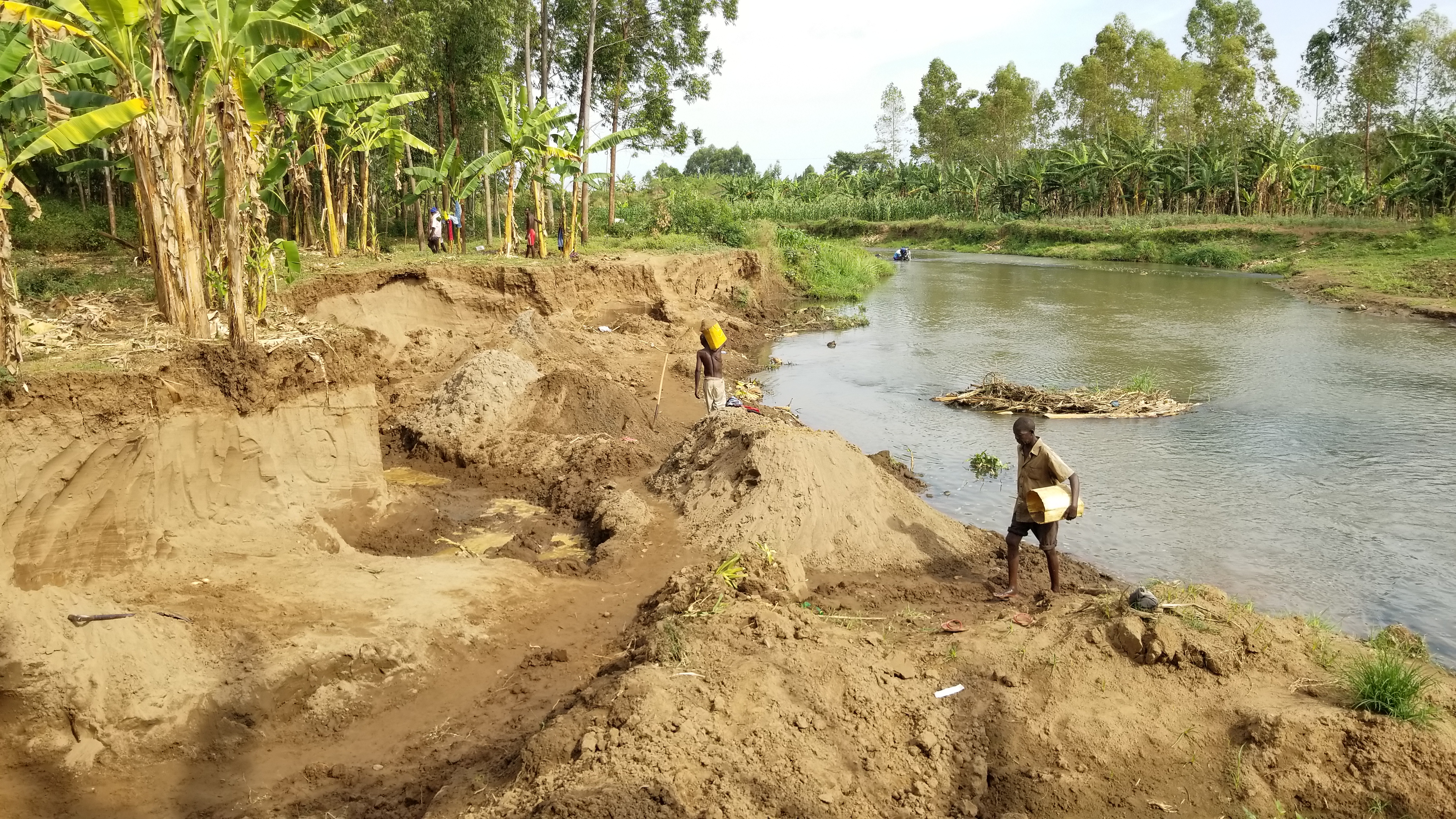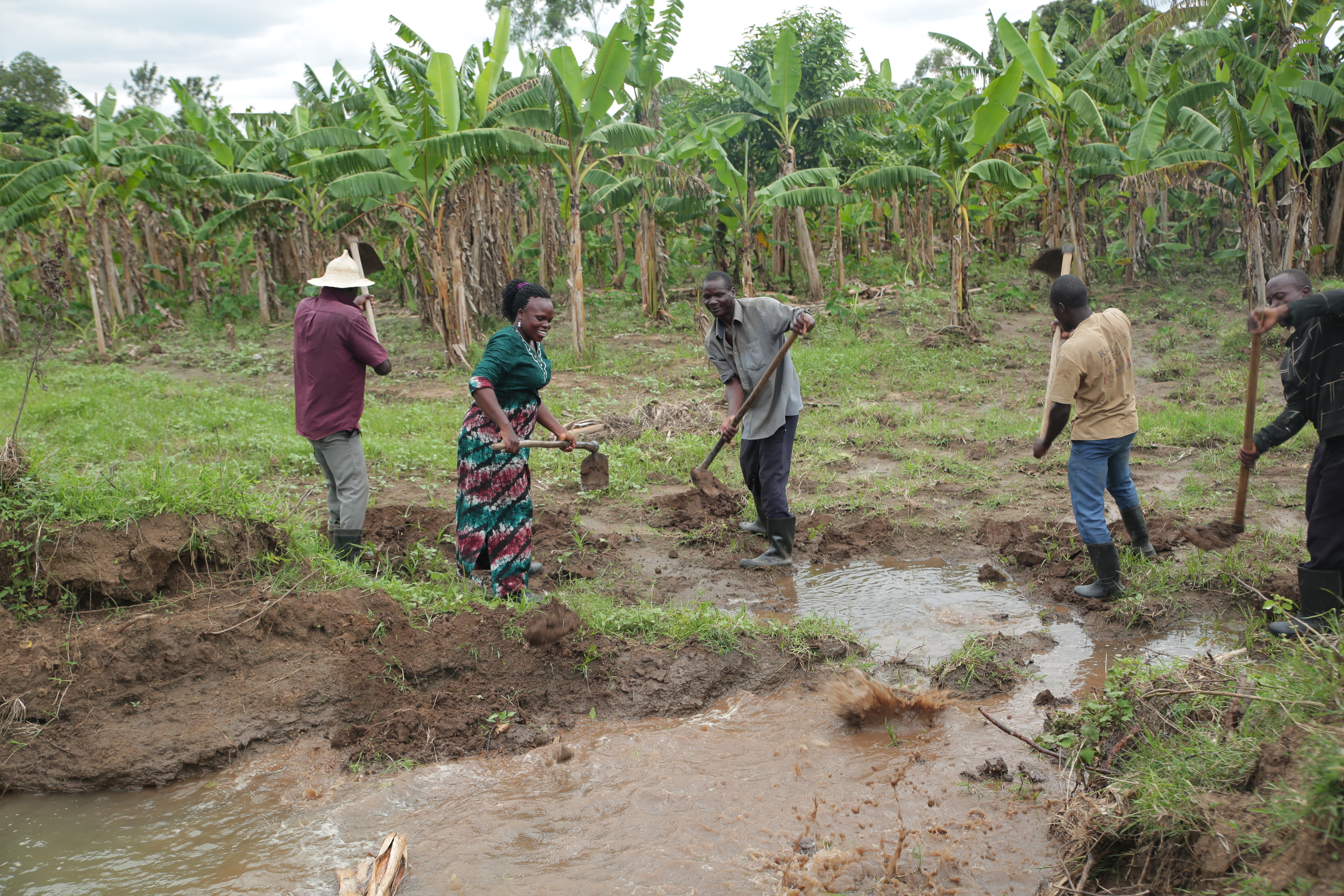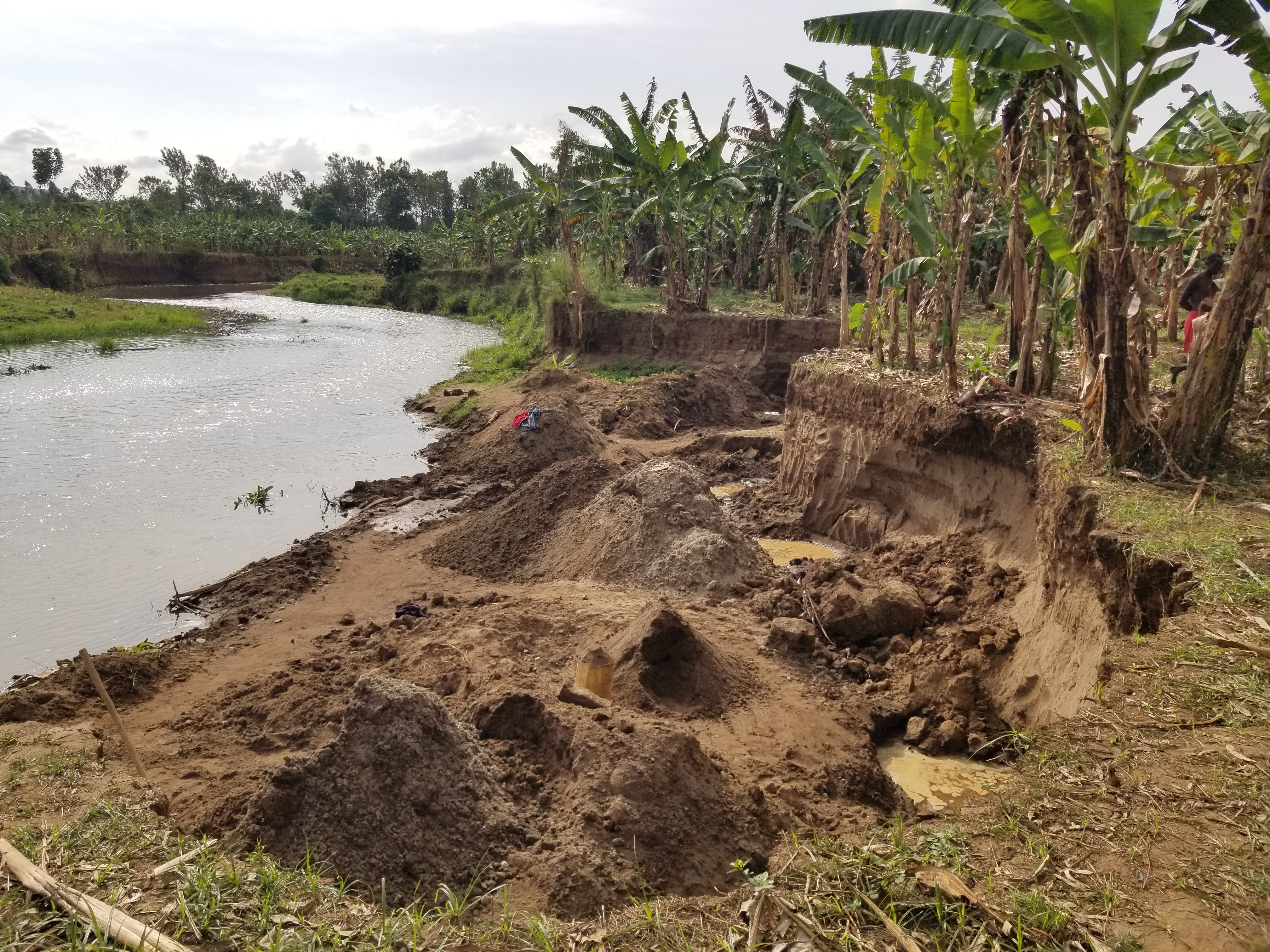
By Leonard Mukooli
MBALE- High in the bright green folds of Mount Elgon, where mist clings to ancient trees and the earth breathes life, River Manafwa begins as a timid trickle. Here, in the sacred Bududa District forests, the river is born from rain and spring, its waters cold and clear, cascading over rocks like a melody.
As it takes on its long-life journey downhill, feeding life into communities across Bududa, Manafwa, Mbale, and Butaleja before merging with River Mpologoma in Namutumba districts as it feeds into Lake Kyoga, the river faces threats of extinction.
What was once a reliable source of water and nourishment for thousands is now in danger, as deforestation, pollution, and unregulated human activities threaten its very existence. Experts, environmentalists, and government officials are raising the alarm, warning that if urgent measures are not taken, the river’s decline could have devastating consequences for both people and the economy.
The Lifeline of Communities
River Manafwa is more than just a water body for the people living along its banks. It is the primary source of domestic water, supports irrigation, and sustains small-scale fishing activities. “Upstream, we see a reliance on the river for household consumption, watering livestock, and some irrigation,” says Enock Makobi, Country director of Trees for the Future.
This organization has been working with farmers to encourage agroforestry and sustainable land-use practices. “We teach farmers to plant trees along the riverbanks to protect the soil and minimize erosion,” Makobi explains.
Further downstream, the river’s use intensifies. In areas like Butaleja, large-scale irrigation schemes have been established, transforming vast stretches of land into rice paddies that fuel the region’s agricultural economy. But as demand for the river’s resources grows, so does the strain on its ecosystem.
Along the course of River Manafwa, the landscape tells a heartbreaking story. The upper reaches, where water once tumbled over rocks in playful abandon, are now bare and fragile. Deforestation in Bududa and Manafwa districts has left the hillsides exposed, forcing soil into the river during heavy rains.
The 70-year-old Paul Wabwyanga, an elder from Buweswa sub county in Manafwa district, stands at the river’s edge, shaking his head in anguish as he points to the eroded banks of the river Manafwa.
“I have lived here for over 60 years, and I have never seen the river like this. The trees that held the soil together are gone. Now, every time it rains, the river turns dark brown, thick with mud. The soil that should be growing our food is being washed away,” he laments.
Makobi observes that the deforestation crisis in the manafwa water catchment is driven by the desperate need for wood for charcoal and firewood. In villages where electricity is still a luxury, trees are cut down daily to fuel homes and businesses. Each fallen tree strips away a layer of protection, allowing rainwater to run freely, carving deep wounds into the land and draining the river of its strength.
Further midstream in Busiu town council Mbale District, where the river used to flow steadily, it is now sluggish, its banks receding like the hairline of an aging man. The once fertile wetlands that flanked the river have been converted into farmlands, suffocating the delicate ecosystem that maintained its balance.
“We had no choice,” explains Sarah Namukhula, a widow and mother of five who grows maize by the riverbank. “The land up the hills is exhausted, so we came down here to farm. If I don’t grow food, my children don’t eat.”
But this encroachment comes at a cost. Without the natural vegetation to regulate the river’s flow, it has become unpredictable. In the rainy season, it swells violently, bursting its banks and swallowing farms and homes. In the dry season, it shrinks, barely recognizable, forcing entire communities into water scarcity.
It's known among the people here in bugisu that for generations, the rich soils of the Elgon region have supported agriculture. But the growing population has put immense pressure on the land. Farmers, desperate for space, have encroached on riverbanks, clearing away vegetation and cultivating too close to the water.
Today, along the River, it is common to see large drainage channels dug by farmers, diverting water into nursery beds and gardens. This unchecked extraction further weakens the river’s ability to sustain itself.
“We are losing the rivers because of poor farming practices. The soil is washed directly into the water during rains, filling up the riverbeds and making them shallow. This reduces the volume of water they can carry,” says Wabwyanga, noting that the future for the coming generation stands in shambles.
Environmental and Human-Induced Threats
The degradation of River Manafwa is evident both upstream, midstream, and downstream. The massive deforestation in Bududa, Namisidwa, and Manafwa districts has stripped hills and the river’s banks naked of protective vegetation, increasing soil erosion and runoff during heavy rains. “What we are seeing is a direct consequence of a bad land management system,” says Marion Namono, the Environmental Officer for Bududa District. “As people clear forests for agriculture and settlement, they weaken the soil structure. This results in excessive siltation, which is why flooding is becoming more severe.”
This pattern of destruction continues downstream, where the once-thriving aquatic ecosystem is now battling pollution as a result of erosion of agrochemicals that farmers use in their gardens to improve on their yields due to the increasing barrenness that comes as a result of the massive erosion of the organic fertile soils.
Trading centers such as Bunamubi in Bukigai Sub County in Bududa District, Buweswa in Buwangani Town Council in Manafwa District, as well as Shikoye in Mbale District have turned parts of the river into a disposal site of all kinds of waste, including the plastics. “It’s alarming to see how people use the river for drinking water and as a toilet as well as a dumpsite for garbage at the same time,” Marion adds.
“Look at this!” says Namono holding up a water sample vial filled with contaminants. “Microplastics from synthetic fabrics, bacteria from open defecation, this is not just dirty water. It is poison” and tests from the ministry team reveal microplastic levels exceeding global safety thresholds.
In the downstream areas, where many communities, more aquatic life thrived abundantly, is vanishing due to the disruption of the ecosystem. The 67-year-old Moses Wamoto, a fisherman-turned-farmer in Butaleja, recalls in affirmation to the disappearance of some aquatic life. “In the 1990s, we used to catch different kinds of fish and the normal size of a mudfish one caught was long as your arm, but today not even tadpoles can thrive to live in this water.”
Maximo Twinomuhangi, Principal Hydrologist and Team Leader for the Kyoga Water Management Zone, in his sharp voice notes with urgency to save the river for the sake of the life and social economic importance it has. “We are racing against time. If this river dies, entire communities will die with it,” says
He affirms that the increasing level of microplastics in the river is giving it ‘a slow death’, yet it is a lifeline to millions of people who depend on it. Further, he suggests the need for the establishment of incentives that can attract people from dumping the plastics in the water, but rather people can receive a small amount of money from each plastic they collect and dump at some collection point.
Meanwhile, sand mining activities in areas like Bushiyende, Manafwa Town Council, and Busiu have disrupted the natural flow of the river, leaving sections of the riverbed dry and exposing fragile ecosystems to further destruction. “Unregulated sand mining not only alters the river’s course but also accelerates bank erosion,” explains Twinomuhangi, “The river is eating away at its banks, and if this continues unchecked, the damage will be irreversible.”

Government Investments, depending on the river standing, at risk
With the mandate to improve the lives of its people, the Government of Uganda has bet big on River Manafwa. Upstream in Bududa, the Bududa-Nabweya Gravity Flow Scheme, a Shs 24 billion project, pipes water to over 30,000 residents both in Bududa and manafwa districts. In the midstream areas of Busiu town council in Mbale district, the 81-year-old water treatment and pumping station established in the colonial times remains the heart of the supply of water to Mbale City and its surrounding areas amidst the growing population. Downstream, in Butaleja district the Doho Irrigation Scheme, worth Shs 50 billion, supports over 15,000 rice farmers, but these projects are crumbling under environmental neglect.
“Silt is suffocating our infrastructure,” says Deneth Ngabirano, Manager of the Umbrella for Water and Sanitation East. He points to the Bududa-Nabweya scheme, where filters clog weekly with mud. “We spend millions on maintenance money that could build new systems. If the river dies, our investments turn to dust.”
With these challenges in place, there has been an observation in the decline in the consistency in the volume and quality of water supplied to the population. “We hardly get water for home use during the dry season and when it’s the rainy season the quality of water is brownish which we feel is not safe consumption in our homes thus making it expensive for us as we have to boil the water afresh” says Anna Nambozo a resident of Mabole village in Busoba sub-county.
Faith Nembanda, a rice farmer at Doho rice scheme in Maizimasa county, Butaleja district, also notes that volumes of water to her rice paddy are always low during the dry season, thus affecting the quality and quantity of her produce.
“Farming has become a huge gamble for us. When it is the season for the rains, we pray it does not flood and destroy our rice fields, while in the dry spell again you find that we scramble for the little available water that we have to wait for hours to fill the padel and this is so exhausting” says Nembanda.
This gamble has made the Ministry of Water and Environment admit the paradox as projects designed to uplift communities are decelerating in impact as the life of the river declines. “We must protect the river to reap its benefits as intended,” says Ngabirano “Otherwise, we’re pouring water into a broken pot.”
Climate Change Meets Human Recklessness
Another alarming trend noticed is the fluctuation of the river’s water levels. “During the dry season, the river and its tributaries shrinks drastically,” notes Twinomuhangi adding “The tributaries that feed it from the forest are drying up, likely due to climate change and land degradation” as he warns that if these changes continue, the river’s ability to sustain agriculture and human consumption will be severely compromised.
The unpredictable rains trigger deadly floods like the 2023, these that drowned 500 homes in Butaleja, while the dry seasons parch tributaries. Satellite images show the river’s upper catchment, once lush, now bald and bleeding silt.
This unpredictability of the river’s flow has made farming a huge gamble both up and down stream as flooding during the rainy season destroys crops and property, while low water levels in the dry season make irrigation difficult.
“Every year, we report losses due to Manafwa’s unpredictable behavior,” says Stephen Olupot, the manager of Oxfam eastern region. “We need solutions to this challenge and it has to involve all the stakeholders on board before it gets worse.”
“The Manafwa is a mirror of our mistakes,” says Goden Namaya, Deputy Manager for Water for Production East. “When you cut forests, rain doesn’t sink into the soil it rages downhill, stealing soil and lives.”
The Path to Restoration
Efforts to save River Manafwa are underway, but more needs to be done. “We need a coordinated approach involving government agencies, local communities, and environmental organizations,” says Goden Namaya, Deputy Manager for Water Production East. “Restoring riverbanks through reforestation, enforcing environmental laws, and investing in sustainable water management technologies are key steps.”
Although the government through the ministries and NGOs are already working with farmers to promote tree planting and soil conservation, Makobi collaborative efforts to support the goal of environmental restoration “If we can get more people to understand that protecting the river is in their best interest, we can make real progress,” he says.
Meanwhile, Twinomuhangi advocates for stricter regulations on sand mining and pollution control. “It’s not too late to save River Manafwa,” he insists. “But we must act now because the problems we see downstream of the river can be tamed upstream and it is a win-win situation for both communities.”
As the river continues its journey from Mount Elgon to the lowlands of Butaleja, it carries with it both life and destruction. Whether it remains a source of prosperity or turns into a symbol of environmental decline depends on the actions taken today. The time to save River Manafwa is now and it is the responsibility of the government, local communities, and the different development partners that must support each other to reclaim the glory of this mighty and beautiful river.


